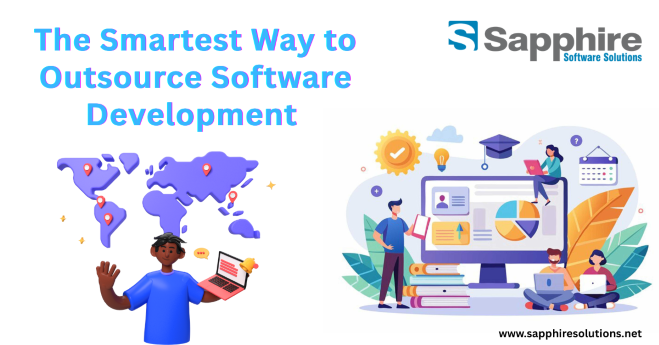Introduction In today hyper-digital world, companies are below steady stress to innovate quicker while maintaining cost in take a look at. Whether you’re a startup building your first app or a massive enterprise scaling up your virtual transformation, the question frequently arises: What’s the neatest way to outsource software program improvement? Outsourcing has developed a long way
Introduction
In today hyper-digital world, companies are below steady stress to innovate quicker while maintaining cost in take a look at. Whether you’re a startup building your first app or a massive enterprise scaling up your virtual transformation, the question frequently arises: What’s the neatest way to outsource software program improvement?
Outsourcing has developed a long way beyond being a value-cutting exercise. Today, it’s approximately getting access to international expertise, scaling teams flexibly, and turning in tasks with pace and first-class. However, now not each outsourcing strategy leads to achievement. To actually maximize your funding, you need to understand the smartest way to outsource software development a strategy that aligns enterprise dreams with technical information at the same time as minimizing risks.
Why Companies Choose to Outsource Software Development
Before diving into the smartest manner to outsource software development, it’s really worth expertise why corporations are increasingly more turning to outsourcing in the first place.
- Access to Global Talent: Outsourcing opens the door to professional, dedicated developers from across the globe, making sure you find the proper expertise at the right fee.
- Cost Efficiency: Hiring in-house teams regularly comes with higher prices—salaries, benefits, schooling, and infrastructure. Outsourcing reduces those prices.
- Faster Time-to-Market: An agile and experienced IT outsourcing company can accelerate shipping timelines.
- Scalability: Outsourcing offers flexibility to scale teams up or down depending on the undertaking’s degree.
- Focus on Core Business: Delegating technical obligations allows corporations to pay attention to their core capabilities, like income, customer support, or product innovation.
The international outsourcing market is projected to attain over $730 billion by 2030, driven in large part by virtual transformation and the demand for software-driven innovation. Clearly, the trend isn’t slowing down. The query is: How do you leverage it in a clever manner?
Common Pitfalls in Outsourcing
While outsourcing gives limitless advantages, many businesses fall into traps that reduce performance and cause frustration. Avoiding these pitfalls is critical if you’re aiming for the smartest way to outsource software development.
- Poor Communication: Without clean communication channels, projects can be disrupted quickly.
- Undefined Scope: Unclear task requirements regularly cause delays and cost overruns.
- Choosing the Wrong Vendor: Partnering with a team that lacks the right understanding can compromise greatness.
- Cultural and Time-Zone Barriers: If not managed properly, those can cause misunderstandings and slower turnaround instances.
- Lack of Transparency: Businesses frequently fail to get regular updates, making it difficult to track music development.
By being aware of these challenges, you can build a smarter outsourcing model that avoids unnecessary risks.
The Smartest Way to Outsource Software Development
So, what exactly is the smartest way to outsource software development? It’s no longer a one-size-fits-all answer but a combination of strategy, verbal exchange, and alignment. Here’s a way to make outsourcing work for you:
1. Define Your Goals Clearly
Before engaging any outsourcing accomplice, be crystal clear about your dreams. Are you looking for offshore development to reduce prices, or do you opt for nearshore outsourcing for better collaboration? Defining your imaginative and prescient enables aligning expectations from the beginning.
2. Choose the Right Outsourcing Model
Outsourcing isn’t confined to one model. Depending on your business wishes, you may choose:
- Staff Augmentation: Hiring dedicated developers to increase your team.
- Project-Based Outsourcing: The dealer takes the entire responsibility for handing over the challenge.
- Managed Services: Long-term engagement in which the outsourcing accomplice manages IT operations from start to end.
The smartest manner to outsource is to select the version that enhances your current resources.
3. Prioritize Communication and Collaboration
Strong communication is the backbone of successful outsourcing. Use equipment like Slack, Jira, or Trello to ensure smooth collaboration. Agile methodologies also play a huge role in fostering transparency and adaptability.
4. Focus on Quality, Not Just Cost
While cost-saving is usually a big reason to outsource, don’t allow it to overshadow high quality. Partner with outsourcing agencies that emphasize innovation, reliability, and long-term relationships. The smartest outsourcing selections are those that create cost, not just financial savings.
5. Build Long-Term Relationships
Outsourcing isn’t a one-off deal. By treating your outsourcing companion as an extension of your team, you benefit from loyalty, accountability, and smoother venture execution.
Trending Outsourcing Models for Business Development
As technology evolves, outsourcing models are getting extra sophisticated. Businesses now look for more than simply cost savings—they demand agility, innovation, and scalability. Here is a few trending techniques aligned with the smartest way to outsource software development:
- Agile and DevOps Outsourcing: Ensures faster transport cycles and continuous improvements.
- Cloud-Based Outsourcing: Many agencies are leveraging cloud structures to enhance scalability.
- AI-Powered Outsourcing: Integrating synthetic intelligence into outsourced tasks improves efficiency and predictive analytics.
- Cybersecurity-Focused Outsourcing: With rising cyber threats, corporations prefer partners who prioritize protection.
- Outcome-Based Outsourcing: Payment models tied to effects rather than hourly billing are gaining reputation.
These traits display that outsourcing is not just transactional—it’s strategic.
Outsourcing vs. In-House Development: Which is Smarter?
Many business owners debate whether to hire in-house teams or outsource. While both have merits, outsourcing frequently emerges as the smarter choice, mainly for startups and mid-sized groups.
- In-House Pros: Better control, closer collaboration, and deep alignment with corporate tradition.
- In-House Cons: Higher charges, limited talent pool, and slower scaling.
- Outsourcing Pros: Access to global understanding, lower prices, scalability, and faster challenge of completion.
- Outsourcing Cons: Requires trust, clear contracts, and cultural alignment.
When accomplished correctly, outsourcing affords the ability and innovation organizations want to stay competitive. It is regularly the best way to outsource software development while boom and value optimization are priorities.
Best Practices for Smart Outsourcing
To maximize the benefits, here are some actionable first-class practices:
- Conduct Vendor Research: Check portfolios, customer evaluations, and case research.
- Sign Clear Contracts: Include timelines, deliverables, and excellent requirements.
- Start Small: Begin with a pilot task to evaluate the outsourcing companion.
- Ensure Transparency: Regular progress reports and overall performance monitoring are a must.
- Adopt Agile Methodologies: Iterative development ensures flexibility and adaptability.
Benefits of Smart Outsourcing
When done correctly, outsourcing brings many advantages.
- Cost Savings: Hiring in-house developers can be expensive due to salaries, benefits, and overhead. Outsourcing provides access to skilled talent at a fraction of the cost.
- Global Talent Access: Businesses can tap into developers with specialized expertise from around the world.
- Faster Results: Dedicated teams can focus solely on your project, reducing development time.
- Scalability: Outsourcing makes it easy to scale teams up or down depending on project needs.
- Focus on Core Business: Companies can concentrate on growth, marketing, and customer service while experts manage development.
Common Challenges in Outsourcing
While outsourcing offers many benefits, it also comes with challenges that must be managed wisely.
- Time Zone Differences: Offshore teams may work in different time zones, making real-time communication harder.
- Cultural Barriers: Differences in work culture and communication styles may cause delays if not handled properly.
- Quality Concerns: Choosing the cheapest option may lead to poor-quality results.
- Hidden Costs: If contracts are unclear, unexpected expenses may arise.
These challenges can be avoided by selecting the right partner, maintaining strong communication, and setting realistic expectations.
Best Practices for Long-Term Success
To make outsourcing a long-term success, businesses should:
- Build trust with the outsourcing team by treating them as an extension of the in-house team.
- Provide clear feedback regularly.
- Celebrate milestones and achievements together.
- Invest in long-term relationships instead of switching partners frequently.
These practices build a strong bond and encourage outsourced teams to go the extra mile for your project.
Outsourcing Trends to Watch
The outsourcing industry continues to evolve, with several trends shaping the future:
- Cloud-Based Collaboration: Tools that allow real-time file sharing and development are becoming standard.
- AI and Automation: Outsourcing partners are increasingly using AI tools to speed up development and testing.
- Focus on Cybersecurity: As data breaches increase, security practices are becoming a top priority.
- Specialized Teams: More businesses are looking for outsourcing partners with niche expertise rather than general services.
Keeping up with these trends ensures your business stays ahead in a competitive digital world.
Future of Outsourcing: Smarter, Leaner, and More Strategic
Looking ahead, outsourcing will continue to grow; however, there will be sharper focus on cost introduction. Businesses’ receivers just ask, “How reasonably priced is it?” Instead, they’ll ask, “How much does it add?”
Emerging technology like AI outsourcing, cloud-based solutions, and remote agile teams will redefine what smart outsourcing looks like. Companies that embrace innovation and construct sturdy outsourcing relationships will thrive.
In brief, it is a strategic partnership, not a cost-slicing tactic. It’s approximately aligning desires, fostering collaboration, and handing over measurable consequences.
Final Thoughts
At the end of the day, outsourcing is about more than cutting costs—it’s about unlocking value, scalability, and long-term growth. By choosing the right partner, businesses can transform challenges into opportunities for innovation. Sapphire Software Solutions stands as a trusted outsourcing partner, helping companies build sustainable digital success through expertise, collaboration, and future-ready strategies.
The real takeaway? The smartest way to outsource software development isn’t approximately choosing the cheapest supplier. It’s about growing cost, building long-term partnerships, and ensuring that each outsourced assignment drives commercial enterprise increase.
You Can also read technology insights that boosts your business.






















